Manchester City looked to win the fourth consecutive English League Cup, the journey began at the Etihad Stadium this season. The Citizens faced Bournemouth, a team that was in the Premier League last year. The 2-1 victory seemed to be a routine for Pep Guardiola and his team, but it means something more to City fans.
City are in trouble at the start of 2020/21 campaign with only 13 first-team players available. Therefore, many EDS players are given the chances to train and play with the first team, some made their starts for the team last night. Bournemouth did not surround, they also had chances but failed to grab every opportunity.
In this tactical analysis, I will dissect the tactics of Guardiola and Jason Tindall. It is a classic positional play against a zonal defensive side.
Lineups
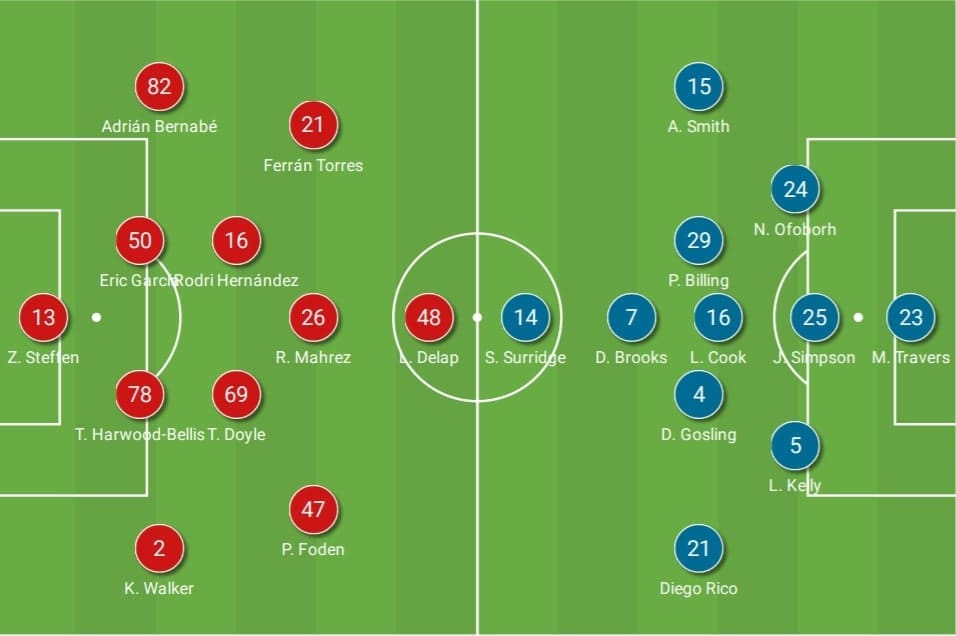
Manchester City did not start with a left-back as Oleksandr Zinchenko and João Cancelo were injured, Benjamin Mendy was on the bench. On paper, Adrián Bernabé took that role. The American goalkeeper Zack Steffen and hot prospect from the academy – Liam Delap both made the first start for the team. The most important was the ideas behind the system, not the formation.
Bournemouth played a very different team from the 1-1 draw with Middlesbrough. Starters in the league – Dominic Solanke and Jefferson Lerma were not in the starting lineup. Many academy players are given chances to play, including Sam Surridge and Nnamdi Ofoborh.
The strong build-up to control the tempo
In this game, City dominated possession and are in control for most of the time. This was because of Bournemouth’s relatively conservative approach – setting a zonal midblock and medium engagement line near the midfield line. Before delving into the offensive approach of City, it was important to understand the defensive system of the Cherries so to identify to strengths and weaknesses.
In general, the defensive shape was a 5-3-1-1 or 5-3-2 if David Brooks and Surridge stayed on the same horizontal line. The duo took care of the central zone, which means spaces near the central circle. The backline tended to stay deep and in shape at the expense of leaving the City full-backs with spaces. However, Diego Rico and Adam Smith still need to cover the wide zone if the channel was being attacked.
The midfielders were vital in the setup. The job of initiating a press fell into the wide midfielders – Phil Billing and Dan Gosling as City tended to operate outside of the Bournemouth block. The intended coverage area should be as highlighted as follow. If the ball was at the wide zone (i.e. zone 7 and zone 9), they would not step out to press.
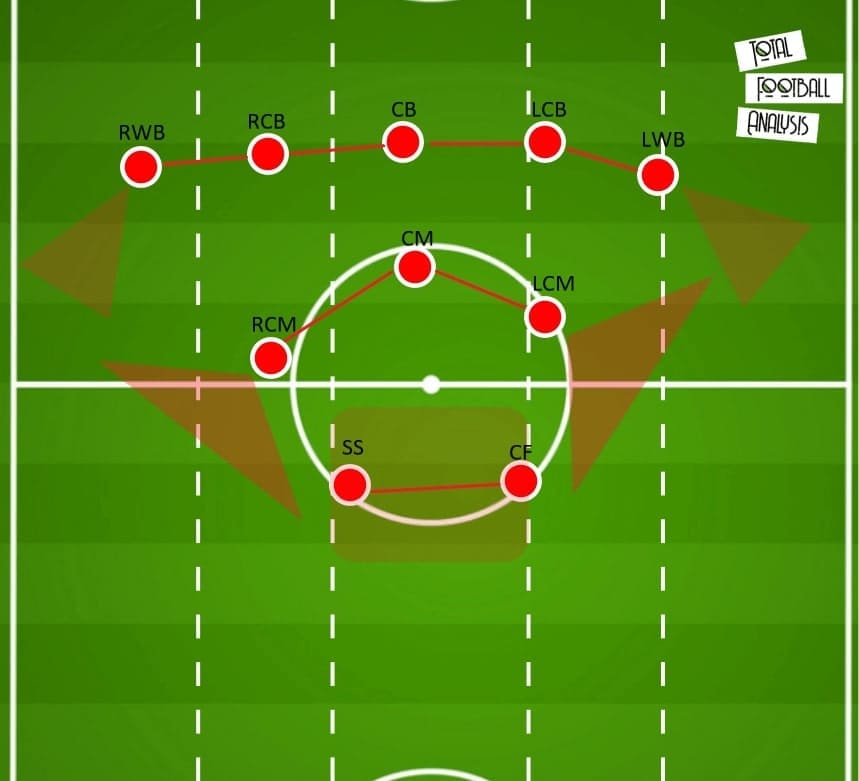
For Pep, even positions of players are not the most important. The key was the way to exercise the ideas on the pitch as we see Bernabé was the left-back. The build-up shape was a 2-2 boxed, formed by the double-pivot and the centre-backs. By interpreting the defensive shape of Bournemouth as a pentagon for the pressing five, City were clear to avoid centre-backs passing vertically into the pentagon. Apart from not falling into the Cherrie’s pressing trap, the verticality of these setups also limited the next moves of receivers.
The jobs of Rodrigo Hernández and Tommy Doyle were different. Both were playing quite well today – Doyle impressed by escaping the opponent in one v one by tricks, also making quick decisions. However, Doyle mainly stayed at the centre to absorb and manipulate the first defensive line. Comparatively, Rodri enjoyed more freedom to roam his positions. He could be the left-back, playing very wide to receive the ball without pressure. Or, he could operate at the half-spaces (zone 7.5 and zone 8.5) to pull the wide midfielders out of positions. This created spaces behind the block or for the wide players.
The likes of Phil Foden and Riyad Mahrez roamed positions by dropping from the blindside of Cherries’ midfield, connecting switch of directions to wide players. Ferran Torres had a different task; he pushed higher to support the striker and provided another point of offensive heights, also continuously searching to attack depth. The full-backs should attack the wide channels, including crossing and exploiting one v one opportunities.
As the centre-forward, Delap was a different type of striker than Gabriel Jesus. He has shown the strong physicality and pace to attack depth. In this game, he has to try occupying two centre-backs by staying between the holes. This was also an important job to separate the Bournemouth lines horizontally.
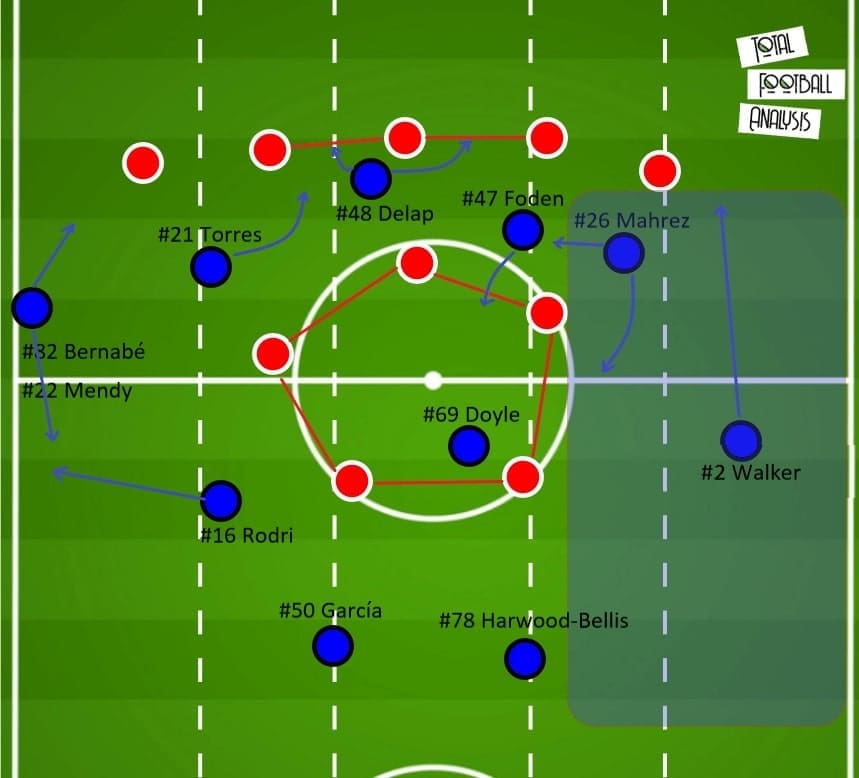
In the following analysis, I will give some in-game examples to further elaborate on the tactics of both managers. The first one was about the build-up of City. As I have drawn, it was a 2-2 shape with a pair of wide full-backs. No City player was trying to get into the pentagon as the ball progression mainly developed through half-spaces or flanks.
As explained, Bournemouth defended zonally, and this was a case that Billing should press. Surridge was uninterested on approaching Rodri as this was not his zone to defend. However, Billing seldom sprint enough to attack the ball and forcing a difficult pass. It was too easy for City to bypass the defensive layers one by one.
In addition, Torres perfectly-staying between the right wing-back and right centre-back, keeping both under control. This consequently left Bernabé as the free player to progress the ball. A detail of this approach was the timing of Rodri’s pass – it could only be played after Billing comes out. Too early, Billing can instantly catch Bernabé.
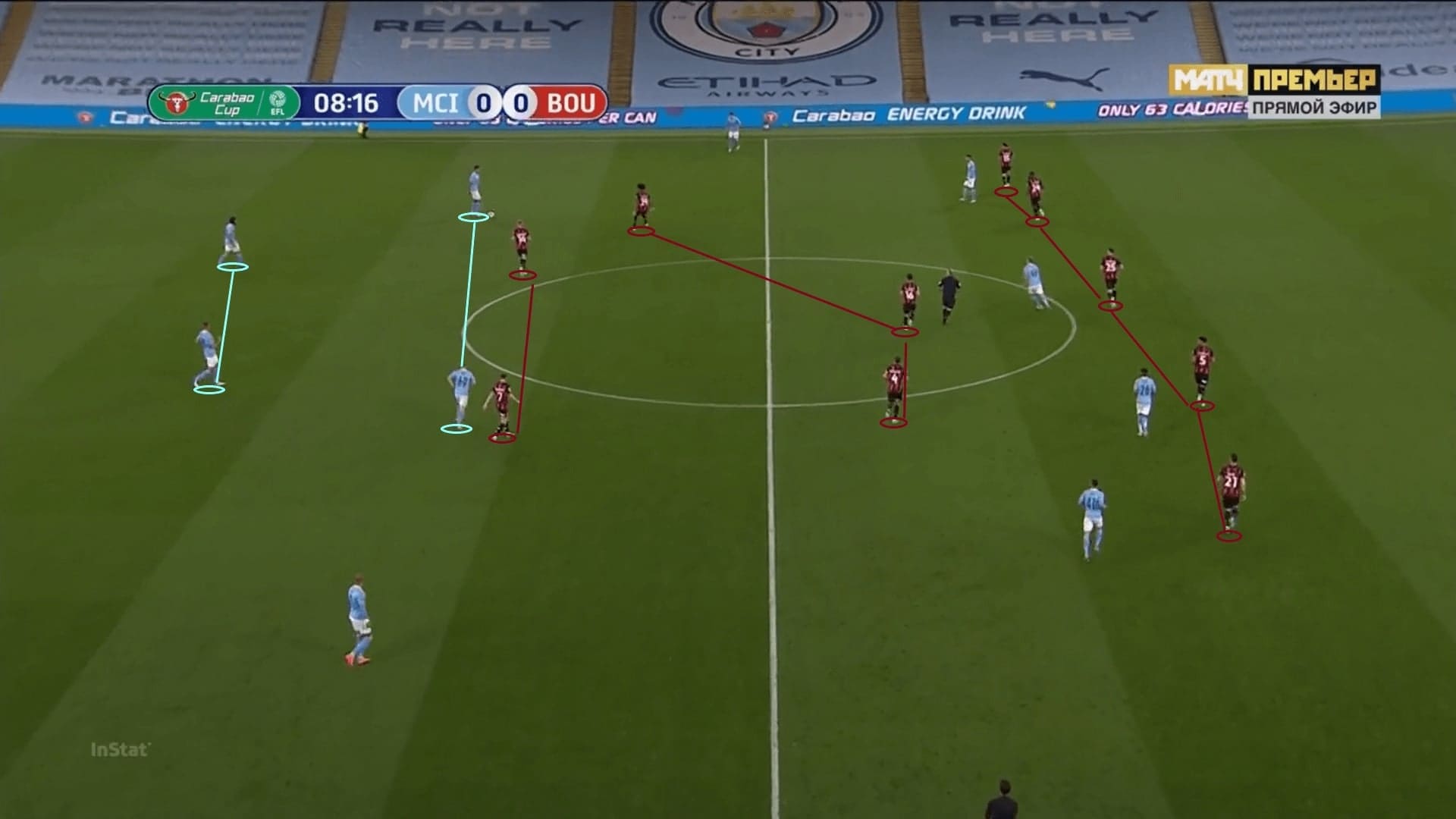
From a macro perspective, City were attacking like a 3-2-5. The gist of the setup was to occupy every vertical channel in the attack with the help of a pair of wide full-backs. However, Pep’s men were better than dogmatically using a front five to match a back five. Instead, they still created one or two free players to attack with this approach.
Here, several City players positioned themselves smartly by staying between two players. For example, Torres, who was in the vertical gap between Billing and Smith; Delap was in the horizontal gap between Jack Simpson and Lloyd Kelly. Therefore, Bernabé and Kyle Walker became the free players on both flanks.
This time, Rodri was the man to absorb the pressure at the centre. City progressed through a wide pass to Bernabé to the wide zone.
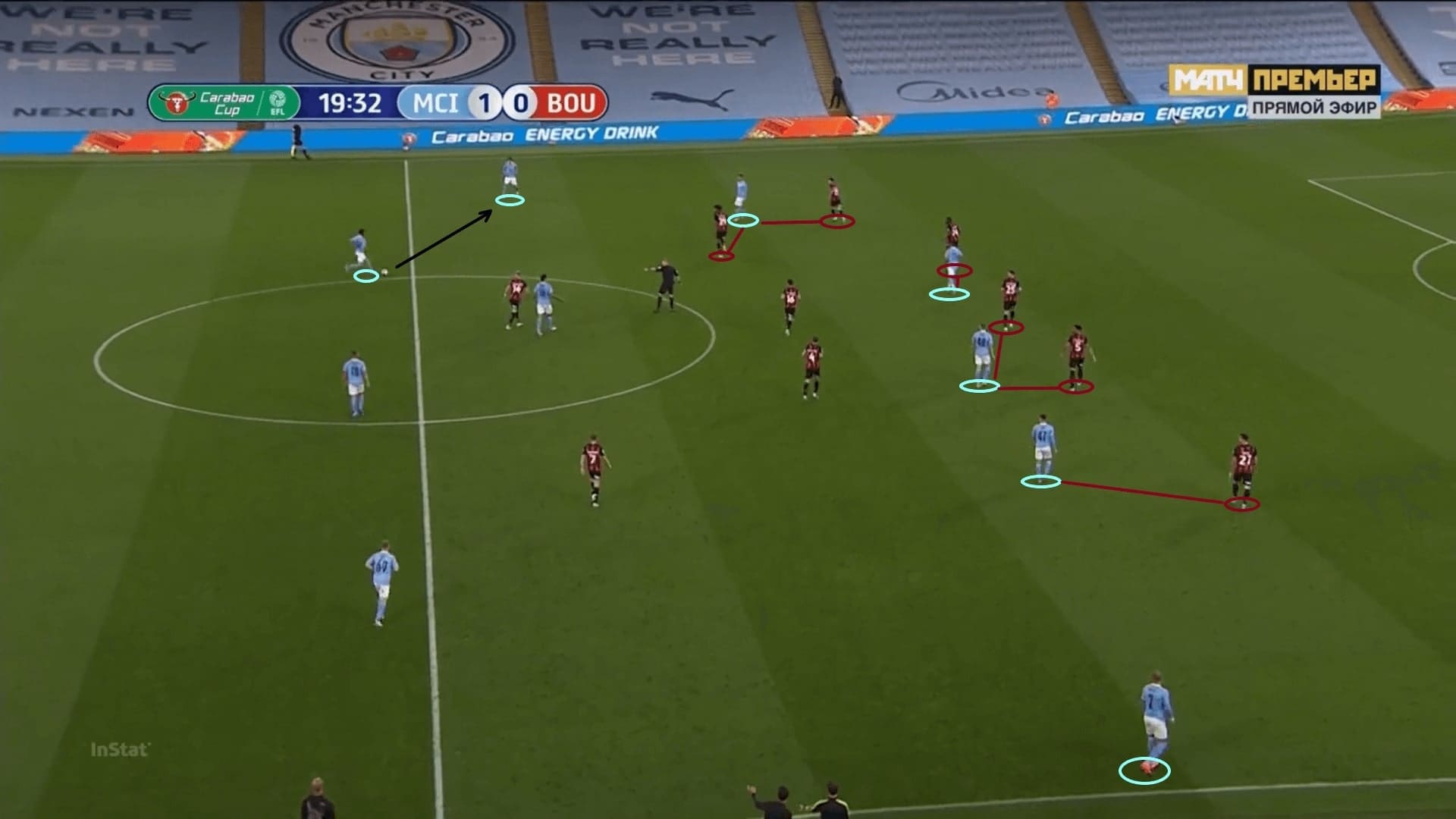
Another main way for City to move the ball up was using half-spaces by dropping players. The idea was the same – operate outside of the pentagon. With the full-backs joining the attack early, a dropping player could be free to carry the ball forward.
In this case, Mahrez dropped to support Rodri, who stayed at the edge of the pentagon, unreachable by the first layer. Foden cleverly positioned himself between L. Cook and Kelly to open the highlighted region for the Algerian international. Walker was not in the frame, but his presence at the wide zone has Jordan Zemura’s position, so Mahrez could drift into the zone without confronting pressure.
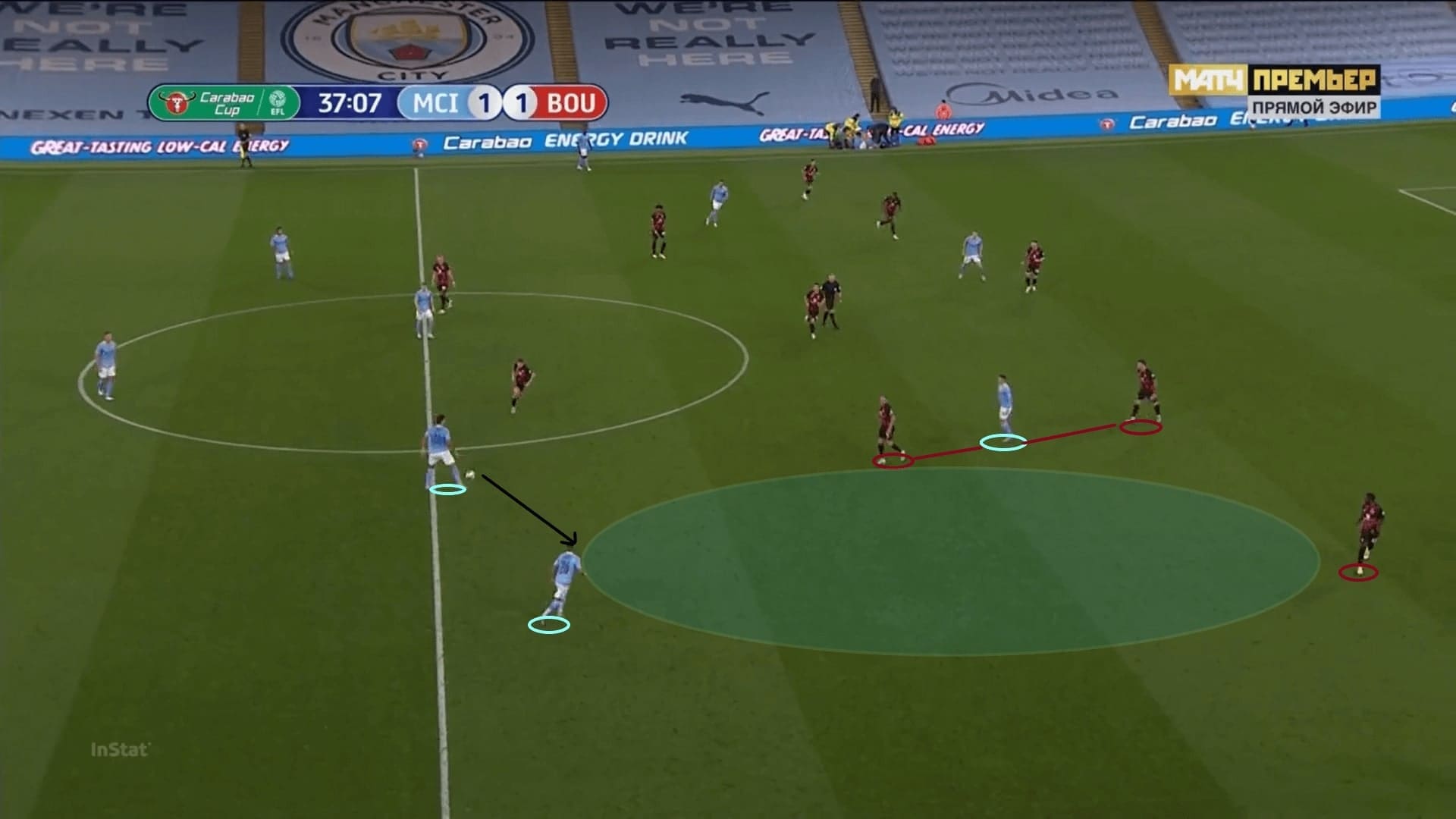
Inside the final third
In the first half, against a more disciplined and concentrate Bournemouth’s side, City spent more time in the build-up. Pep’s men had some opportunities by forward runs that attacked the depth behind the defence. Torres and Mahrez both got their chances from a reversed movement, denied by Mark Travers.
If City arrived the final third by build-up, they still capitalised on the zonal system of the opponent on several occasions. Maybe there were communication issues between the Cherries back five and midfielders, as some spaces were not effectively protected after shifting.
This generated one of the best chances of City at the quarter of the hour. Here, both Kelly and Rico moved out to the wide zone to press Foden as a result of a forward run. However, when City regained possession high to organise another wave of attack, Bournemouth failed to cover some gaps.
Firstly, the entire defensive line did not shift to the ball zone, as the other two centre-backs were concerned with the presence of Delap. On the other hand, neither L. Cook nor Gosling intended to track Mahrez, who was exploiting the free spaces left by Kelly. The zonal system collapsed, and they should be thankful to Travers for rescue.
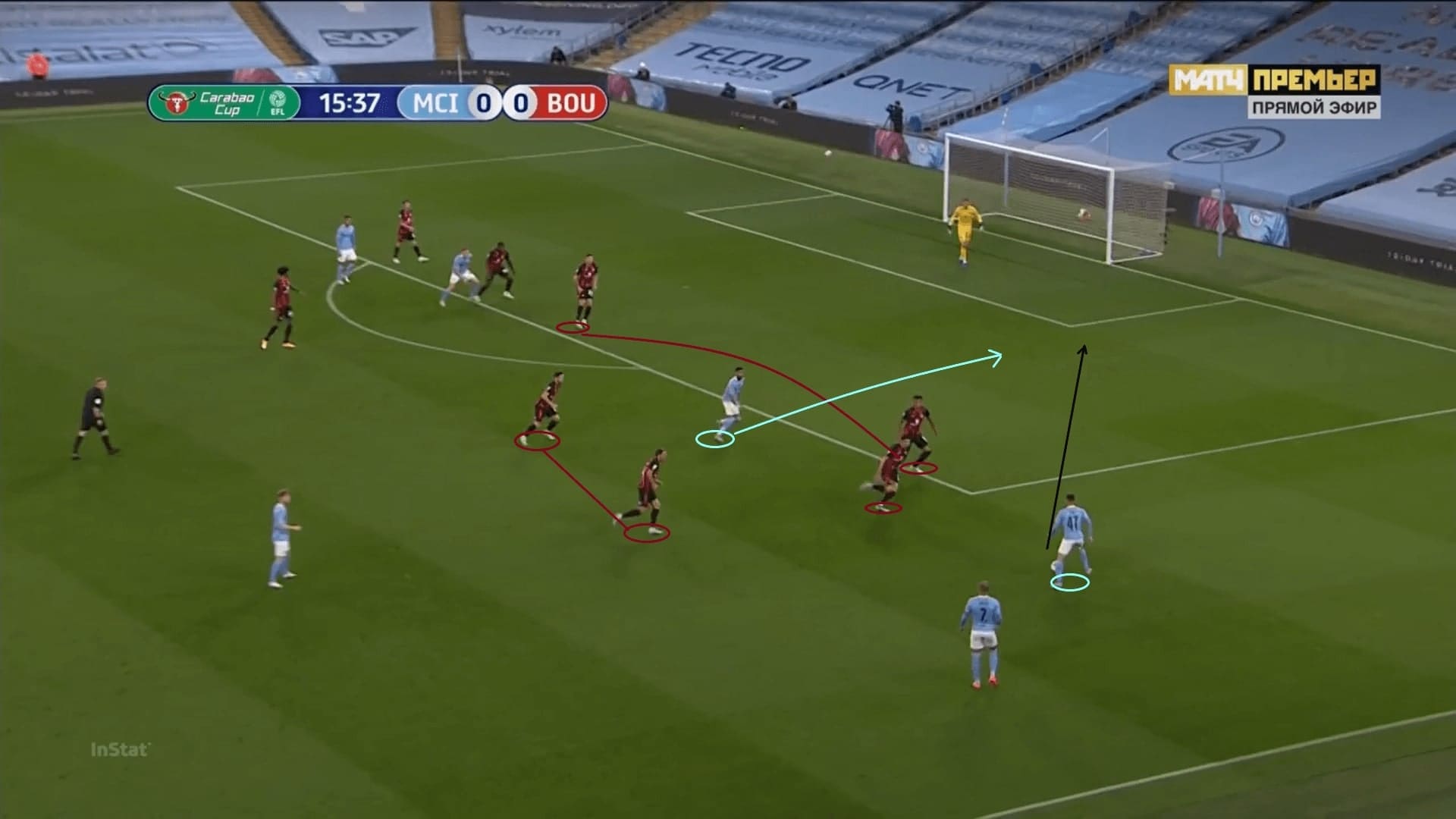
Interestingly, City have changed the way to attack the opponent goal inside the final third. The second half was more opened, and the home side continued controlling the game. There was more time for City to attack inside the final third. But, even reaching the byline, City may not cross because they intended to do something else.
Guardiola took another weapon from his arsenal in the second half. This time, the objective was to overload a flank, then quickly hit the underloaded side to finish or creating opportunities there. This was an approach to avoid losing second balls and conceding unnecessary counter-attacks. If the crosses were all predictable, Bournemouth could dominate in the air, and the situation would hardly be favourable to City.
Therefore, Walker was not interested in crossing early. Instead, he played the ball back to Rodri, who was connected by Foden and the attack ended up at Mendy’s side. The Frenchman left-back could attack in one v one situations to whip in dangerous crosses. Again, the whole flow was done outside of the Bournemouth block; it was a similar concept with the one in the first half.
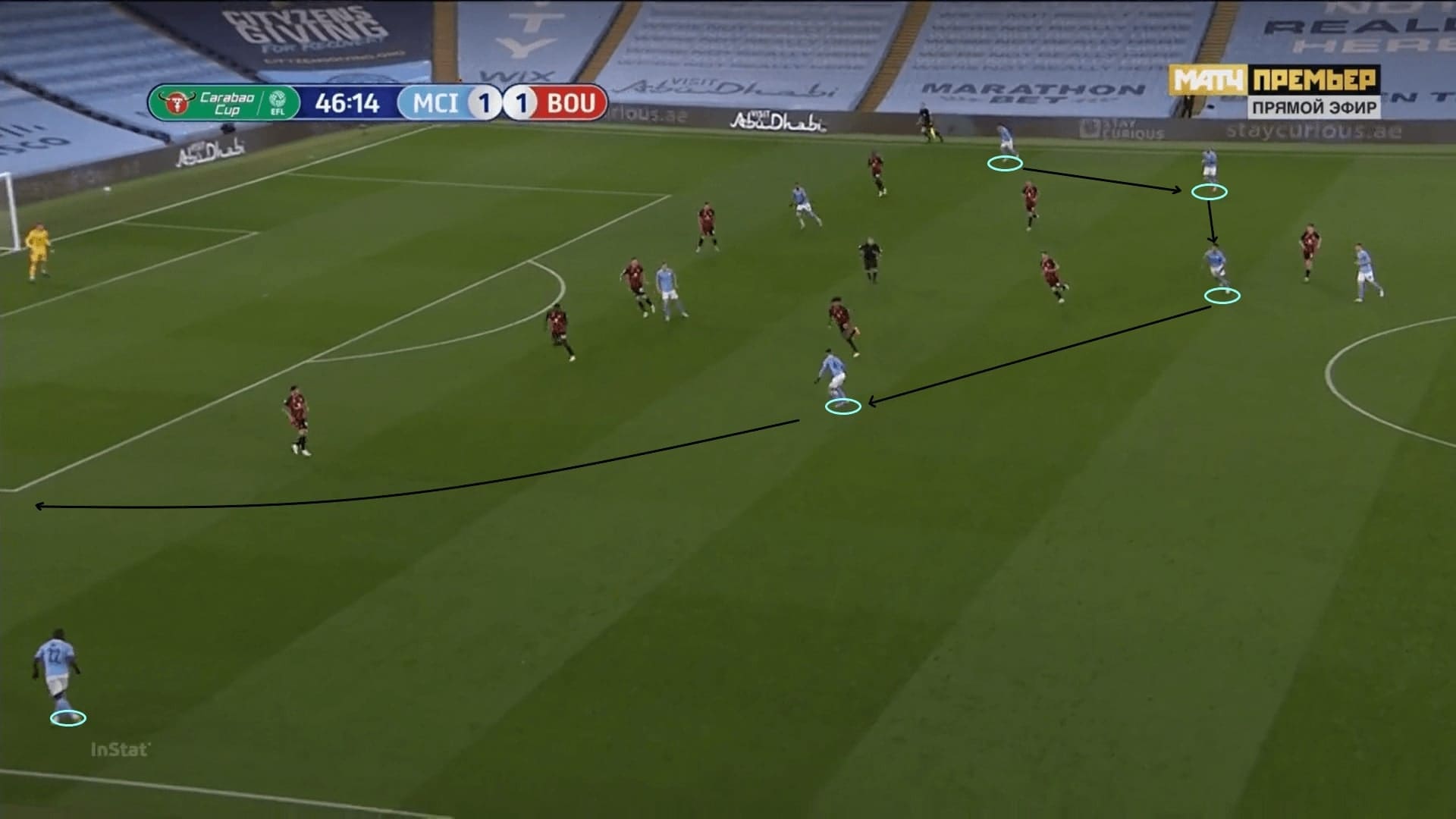
If players are nearer to the penalty box, the approach was more direct as things should not be done complicated. It was a similar scenario where Walker did not cross even in zone 18. The ball went back to Mahrez, who diagonally found Mendy behind the defence. This type of attack was about catching the moment of the defence to push higher. As the Cherries backline was moving, they were unable to change the direction in an instant to track Mendy.
Another change was the way that City attacked the opposition goal. Comparing to the search of attacking depth in the first 45, Delap stayed to pre-occupy the spaces inside the area. This has forced the Bournemouth backline to drop deeper to contain the striker.
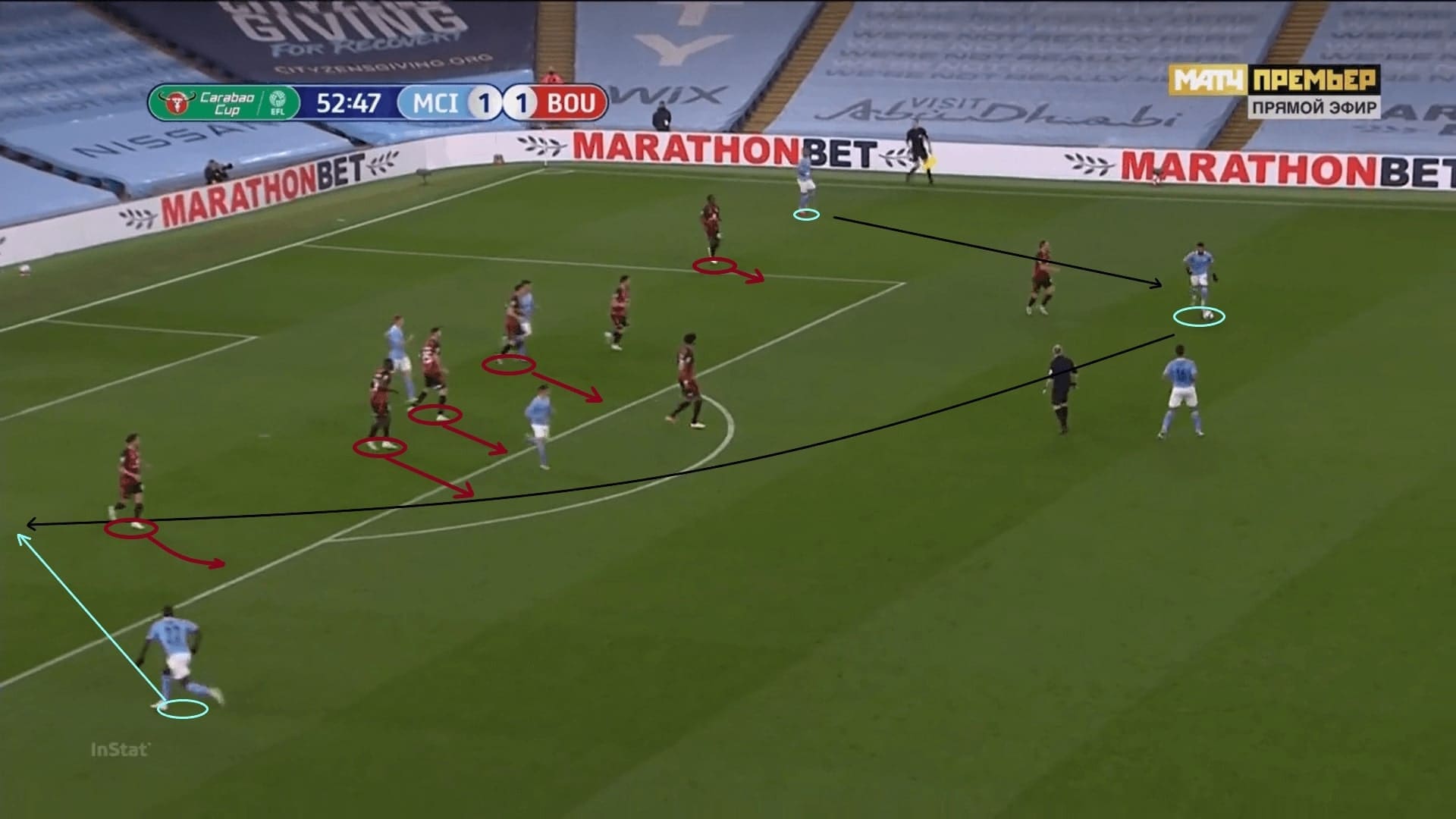
As a complement to the defensive transitions of City, one part that they had done well was to control spaces outside of the penalty box. To suffocate the counter-attacks, the offensive markings should be prepared when attacking in the final third.
Therefore, at least one pivot would stay outside of the penalty box to control those spaces, sometimes two. The below scenario has Foden and Kevin De Bruyne. This was also a part of reasons that contributed to many shots at the edge of the box. City players have good access in the central region after the break, also pulling the trigger from distance.
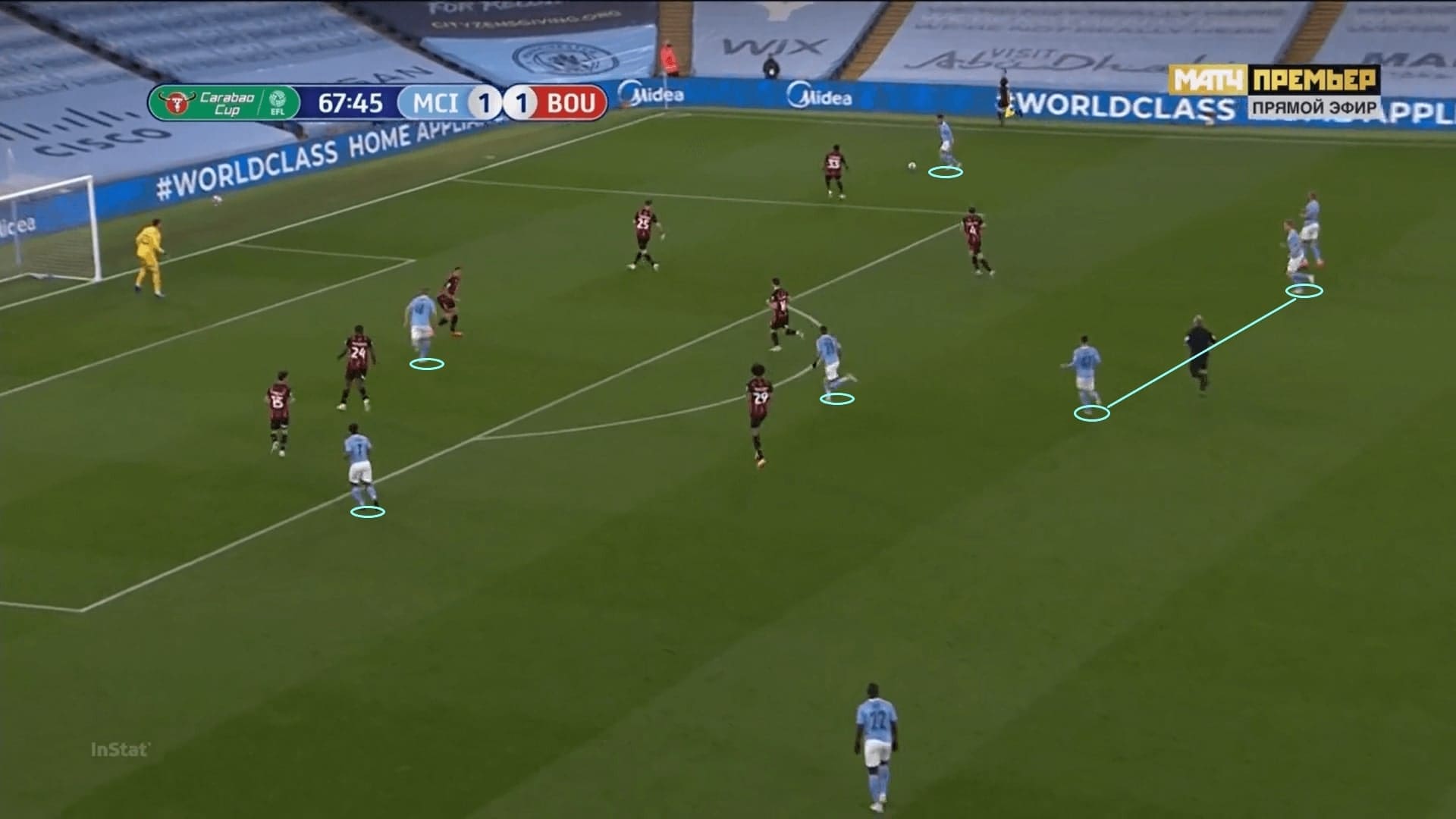
Bournemouth attacks and counter-attacks
Bournemouth merely had three shots in this game; some attacks were attributed to the counter-attacks. Although City had control on most occasions as explained in the above section, sometimes they still gave away the ball sloppily. Hence, counter-pressing was difficult to carry out.
The most important element in the offensive transitions was the depth movements of Surridge. With Brooks carrying the ball forward with pace, Surridge liked to use an outside-curved run to exploit spaces behind the defence.
However, sometimes the carrier has over-dribbled, missing the best timing to release the runner. This has slowed down the attack and City utilised the moments to regroup the defence.
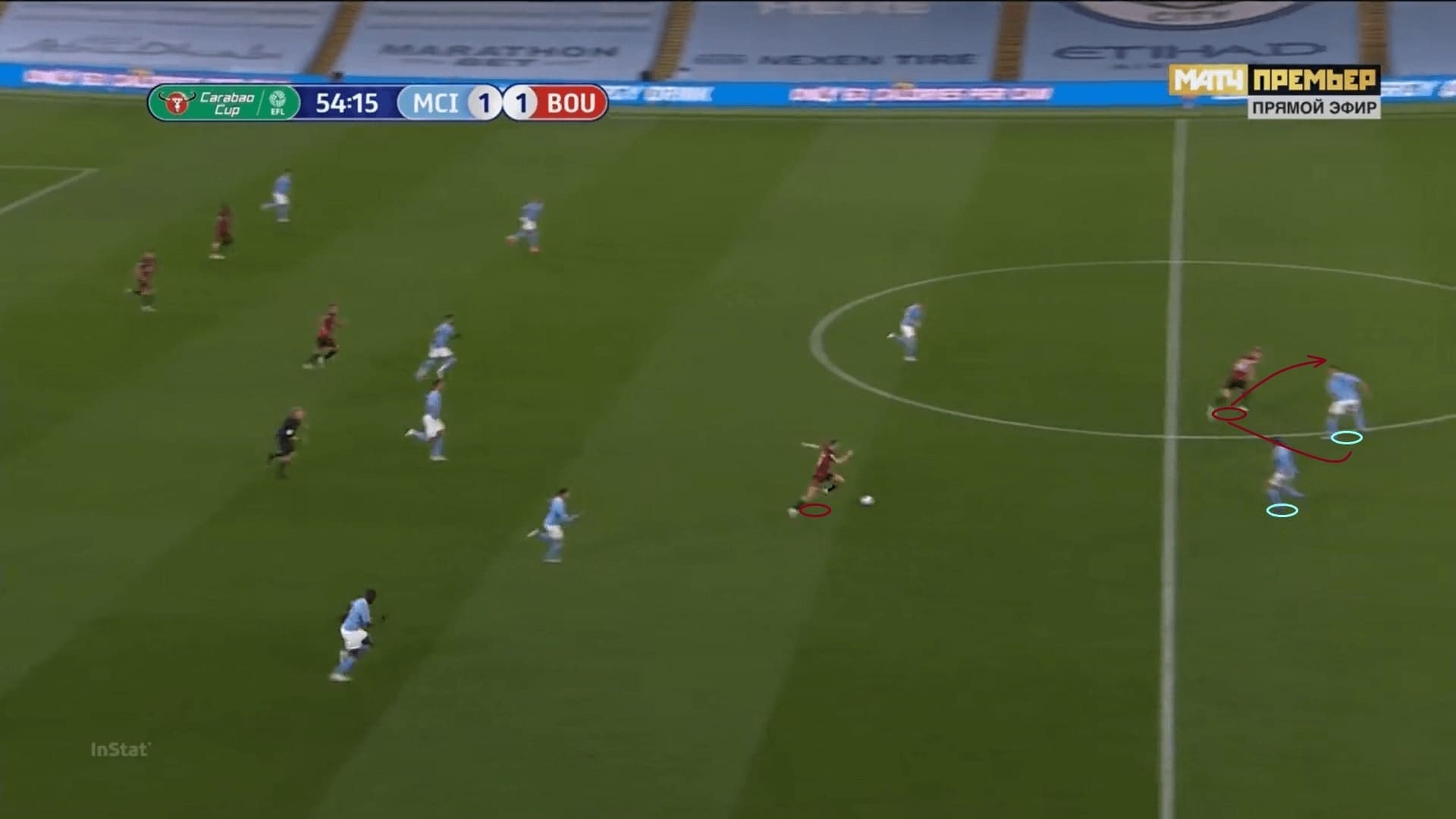
In the open plays, Bournemouth spread the back three, pushing the wing-backs high to organise an attack. Passes were mainly exchanged between the defenders; sometimes the midfielders were used to play wall-passes or 1-2 passes. In the latter stage of the game, the likes of Billing also tried carrying the ball forward.
The attack of Bournemouth relied on Brooks’ pace to make things happen. The below image has shown the wide back three, plus dropping midfielders to play the ball out. The Cherries tried to construct the attack through flanks instead of penetrating centrally. Brooks, as the main man, tended to drop into spaces behind the full-back or exploited the one v one situations. Just like he stayed at the back of Walker in this case.
As the highest player, Surridge would also fall into the ball-side, exploiting spaces behind the backline. The whole shape was like a 1-1 when Brooks has dropped deeper.
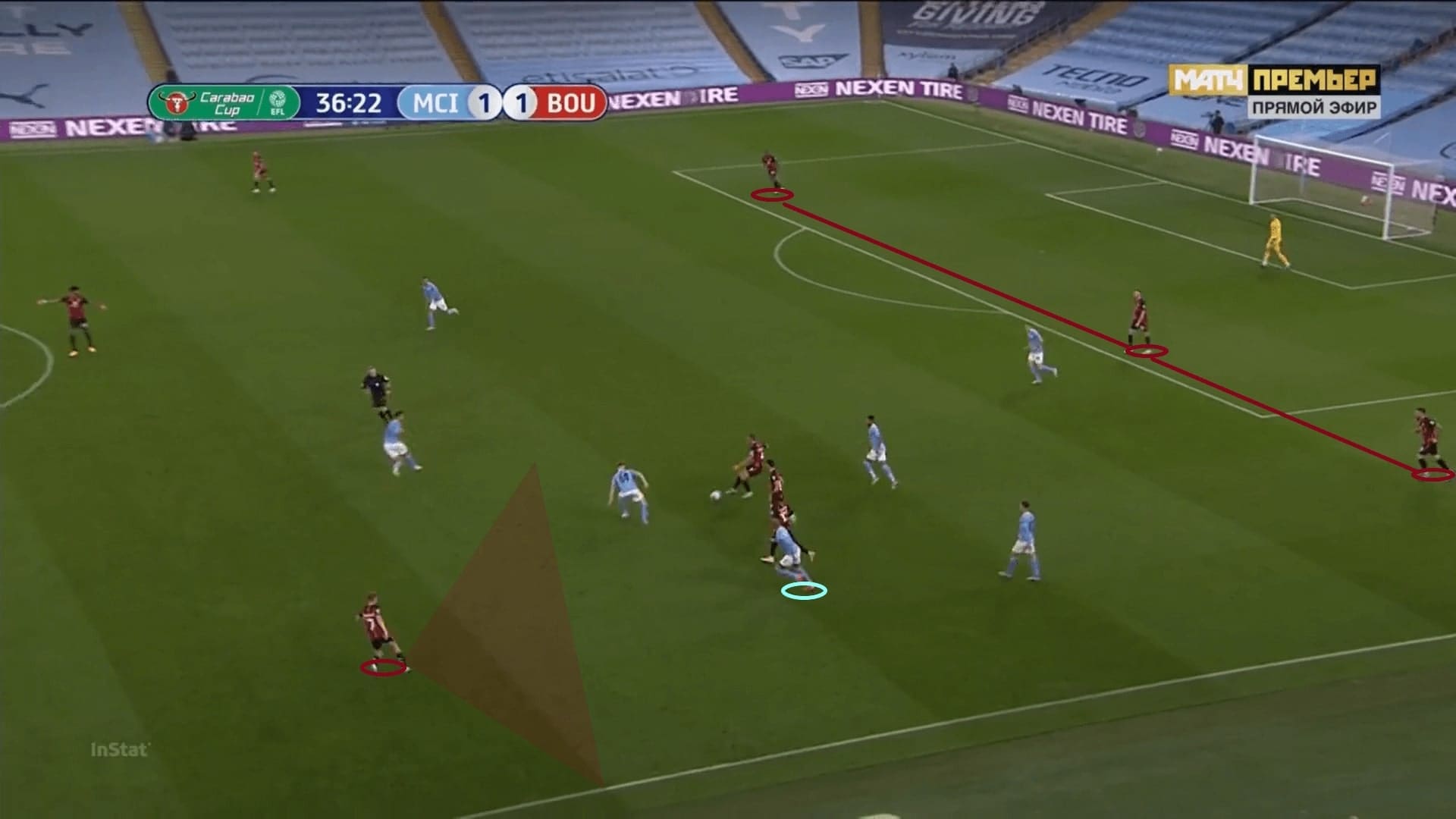
However, an issue was similar to the cases in the first half. It was the timing to release the pass. It takes a relatively long period for Brooks to recognise the runners when he was on-the-ball; the best timing to pass was missed.
From City’s perspective, the delayed timing was the best moment to adjust the positions of defenders, setting an offside trap. As an example, Bournemouth was caught in the below situation because of delaying the pass for a second.
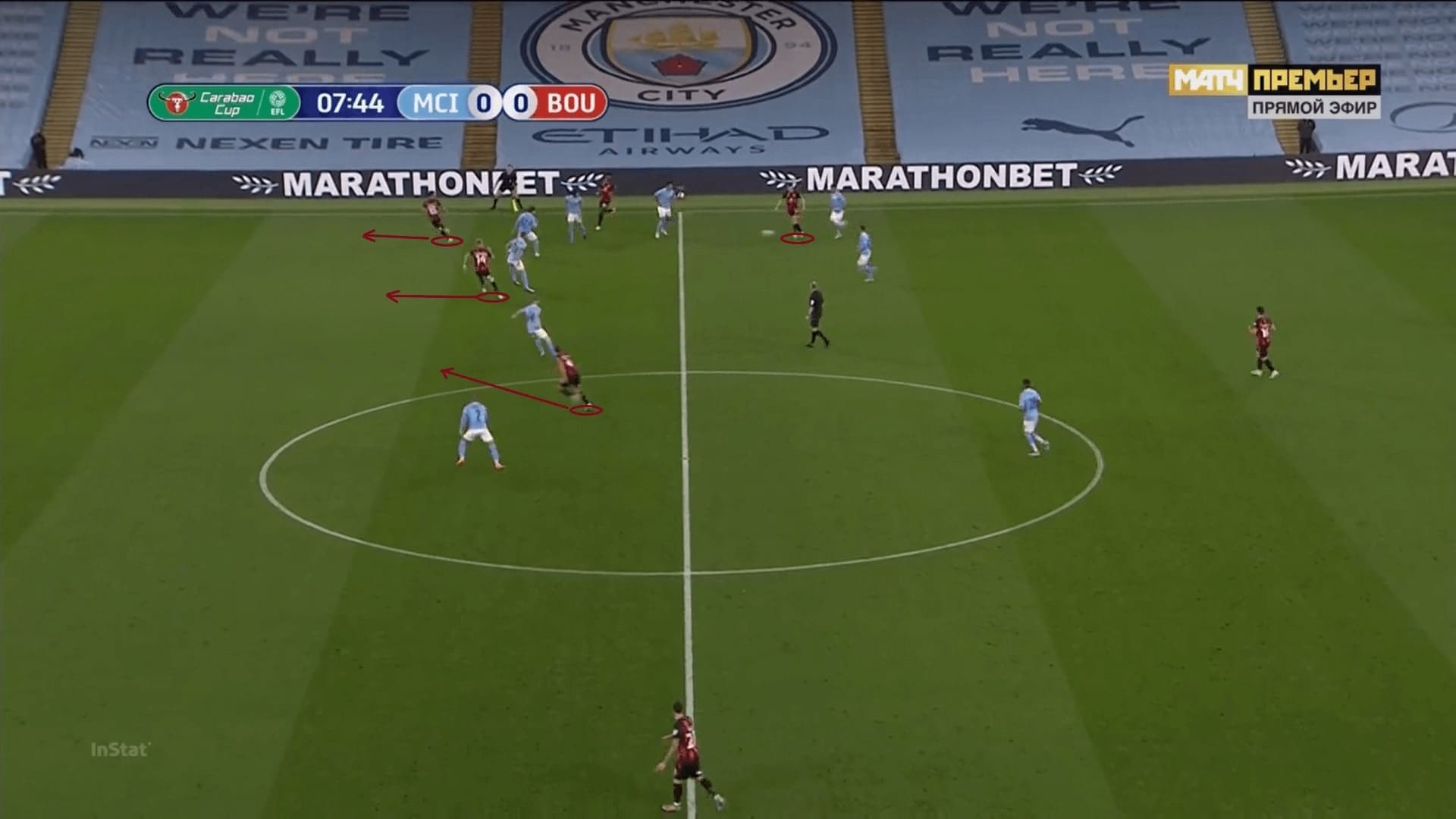
Final remarks
It was not the best game, but still a good game for City. They have used similar strategies that were successful at the Molineux on Monday and also worked against Bournemouth. Pep and his coaching staff once against shown their tactical masterclass through tweaking the tactics slightly during the halftime. In the next round, they will have to face Burnley.
Comparing to the last game here, Bournemouth had fewer opportunities to attack from set-plays and second balls. Instead, the intensity of pressure also dropped a bit, but this is a Carabao Cup game only. Tindall did not play the strongest team as the real focus of the campaign was to regain promotion, which the project continues on Sunday’s fixture against Norwich City.





Comments